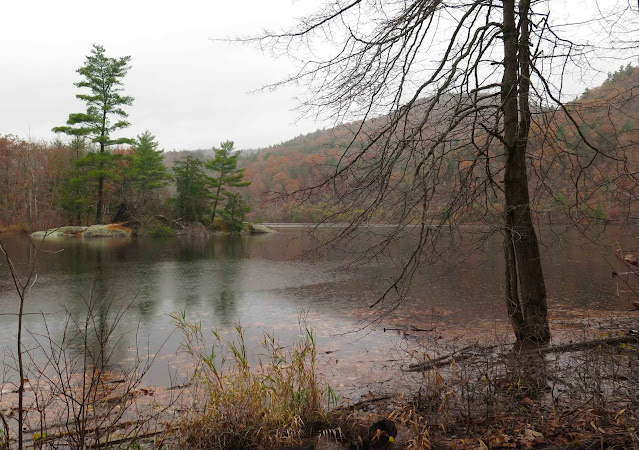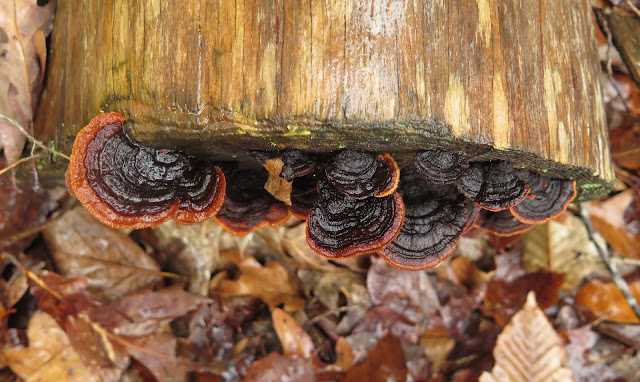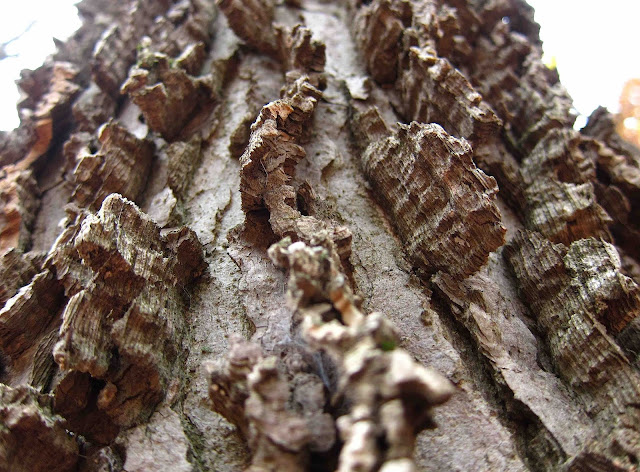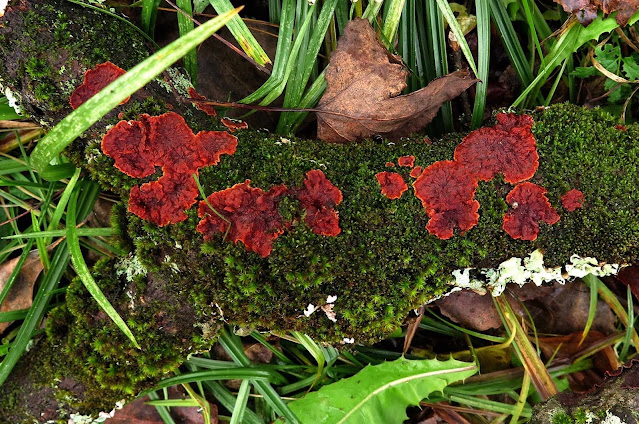Where did the last 10 days go? I sure wasn't here on my blog! And it all seems a blur of various appointments that busied my days, plus several days spent reacting to a Covid booster shot that had me napping under heaps of blankets three afternoons in a row and not spending much time outdoors. I did manage to get out here and there and take a few photos, so I'll post some now, just to catch up.
November 7, Bend of the Hudson River, Moreau: This was such a beautiful Sunday afternoon, my husband wanted to join me for a walk. And we did have a lovely walk through an old abandoned cemetery back in the woods. Usually, when I walk with my husband, I don't stop to take any photos. But driving home along Spier Falls Road, which follows the Hudson River, we both were struck by the beauty of the river banks made golden by the low afternoon sun, so perfectly reflected in the still water. So I did stop and take some photos.
The Warren County bank of the Hudson, right where the river bends sharply to the northeast:
Looking upstream, north toward Corinth, when the lowering sun cast dark shadows on both riverbanks.

One sunny day last week, the Ice Meadows, Warrensburg: I can't remember which day last week that my friend Sue and I scooted up to a stretch of the Hudson River called the Ice Meadows, north of Warrensburg. We had both found Canada Frostweed (Crocanthemum canadense) doing its frosty thing closer to home, so we hoped to find a related species called Hoary Frostweed (Crocanthemum bicknellii) doing the same thing up north where we'd first learned of this species last summer. But the morning turned out to be too warm for frost of any kind. Oh well, the day was lovely, and so was the river bank. Due to recent heavy rains, though, the Hudson was so high that most of the other plants we'd hoped to find remnants of were well under water. In this photo, I think Sue was searching beneath the wavelets for the basal leaves of New England Violet near where we'd found some last summer. She didn't find them.

High up on the banks, though, we did find some beautiful evergreen Early Saxifrage leaves (Micranthes virginiensis) tucked in among mounds of green moss.
And the leaves of Bearberry (Arctostaphylos uva-ursi) were as glossy and green and lovely as ever.
November 13, the Saratoga County banks of the Hudson at Moreau: I wanted to show my friend Amy Godine the stretch of the Hudson that had inspired this blog back in 2009. Amy, a loyal reader of my blog, is also a marvelous writer and frequent contributor to the magazine Adirondack Life, and she told me she plans to write an article about my blog for this wonderful magazine. Oh my gosh, what an honor! Of course, I'd hoped for a beautiful day, but we got a rainy one instead. No matter. We had a great walk and talk together, and I do believe Amy was truly impressed by the wild natural beauty of this stretch of the Hudson, where forested mountains fall straight to the water's edge and wooded islands dot the quiet bays. And we will have other occasions to walk together, in nicer weather.

As the rain started falling harder, we did not linger long in the woods, but we did pause to note the remarkable color of this fungus. It sure looked like Turkey Tail Fungus (Trametes versicolor) to me, a fungus that comes in many different color combinations. But I had never seen it wearing such Halloween hues as this black and orange!
At least this Violet-toothed Polypore (Trichaptum biforme) lived up to its vernacular name!
November 14, Stark's Knob, Schuylerville: I had been slated to lead my friends in The Thursday Naturalists on a visit to this remarkable geologic site this week. And it is an amazing experience, to stand beneath this huge mound of Pillow Basalt, and imagine being here some 460 million years ago when this site was well beneath the sea and lava poured through a crack in Earth's crust to immediately congeal to solid rock in the water. Just looking at this huge mound of black bulbous rock, I could certainly imagine that lava boiling up from below the sea!
A number of interesting calciphile plants grow from cracks in this calcareous Pillow Basalt. The most interesting of these plants is a fern called Purple Cliffbrake (
Pellaea atropurpurea), and quite a bit of it has found a home here. I was able to clamber up the rock and reach a small patch of it, in order to obtain some photos of both its fertile and sterile fronds. This photo shows the spores that line the undersides of the fertile fronds.
And this photo shows the shorter, more rounded leaflets of the sterile fronds, lacking any spores. Both photos show the dark purple stem that suggested this fern's specific name.
I imagine my friends would be interested in observing this unusual fern
in situ. But the problem is, I can't imagine some of my friends (those who are elderly and less agile than others) clambering up a steep, unstable, and now overgrown path to observe this or other plants that might grow on the Pillow Basalt. And this time of year, few other plants of botanical interest can be found at this site. So I have decided to escort my friends to another interesting site instead, one that is quite near by: the Hudson Crossing Park.
November 15, The Hudson Crossing Park, Schuylerville: This park is not just a scenic walk along the Champlain Canal and the Hudson River, although it certainly is that, with about two miles of easily walkable trails offering lovely views of these waterways. It is also an educational destination featuring signage describing the historical significance of the site for both native people and later arrivals, as well as descriptions of its natural history. There is also a children's play park and a covered pavilion for picnickers. This photo shows a historic iron bridge, no longer used by autos but now converted to a walkway for pedestrians and a lane for snowmobiles.
Here is one of the informational signs along the trail, this one describing the importance of this site to the original human inhabitants of this area. Other signs describe its importance to soldiers during America's War of Independence. (Click on the photo for easier reading.)
Picturesque remnants of old bridges attest to how people of other eras found their way across the Hudson River from this site.
My friend Sue Pierce joined me to preview the walk I'll be leading here later this week. Here, she admires one of the animals sculpted in metal that stand along the trail.
Here's another metal sculpture, this one of a Great Blue Heron. It is so life-like, we are often startled that it does not fly away at our approach.
As for botanical finds, there are many American Bladdernut shrubs (Staphylea trifolia) along the riverbanks. The hollow bladders holding the seeds still remain on many shrubs.
We don't find Northern Hackberry trees (Celtis occidentalis) in most of our woodsy wanderings around this region, but many giant specimens tower over this trail, all displaying the deeply ridged bark that is so distinctive to this native tree.
If any of our bryologist friends join our walk here this week, they will find plenty to interest them. What a contrast of color and texture between these two moss species on the same rock!
Ah, but the FUNGI stole the show today! We sure found lots of different kinds and colors. These Split-gill Fungi (Schizophyllum commune) were very small, but also quite visible against the dark wood of a rotting tree limb.
Who could miss seeing the brilliant red of this fungus, especially as it contrasted with the velvety green of the moss that covered the fallen branch it had sprouted on? The flat wrinkled shape and rubbery texture certainly said Wrinkled Crust Fungus (Phlebia radiata) to me, although I had never before seen this bracket fungus so vividly red.
Here was another deep-red fungus sprouting on a fallen twig. I wasn't quite sure, but could these be the first little growths of Red Tree Brain Fungus (Peniophora rufa)?
In a planter mulched with wood chips, we found dozens and dozens of the tiny fungus called Dung-loving Bird's Nest (Cyathus stercoreus), many still retaining their tiny "eggs" (spore capsules) as well as the crunchy-brown exterior coating that many of the more-mature specimens had already shed.
And here was the genuine fungal bonanza: a single tree stump colonized by lots of different fungi, all fruiting at once! The following photos are my best guesses as to the names of the individual fungi inhabiting this one stump.
The tan wrinkly ones plastered tight to the wood but topped by a rubbery fur-covered flap is Phlebia tremellosa. A known decomposer of fallen logs, this fungus is also called Jelly Rot.
The tiny, teal-blue, ear-shaped discs are the fruiting bodies of Blue-stain Fungus (
Chlorociboria aeruginascens), a fungus we usually see as a blue-green stain on rotting debarked wood. Finding it in fruit is always a cause for celebration.
I have found many coppery or purplish, disc-shaped fungi lately, and I'm still not sure what to call them. I am going to go with Ascocoryne cylichnium this time, the scientific name of a small sac fungus sometimes called Purple Jelly Drops (although that name is also used by another Ascocoryne species that looks quite similar). In this same photo, the itty-bitty orange discs intermixed with the moss are a tiny species of Eyelash Cup Fungus called Scutellinia setosa.
All of the fungi we found on this visit are known to be persistent instead of ephemeral. So I am eager to show them all to my friends when we visit this Hudson Crossing Park later this week.



























Some great pictures
ReplyDeleteThanks
An excellent summation of just PART of what we saw that day ! it was like fungus-palooza.
ReplyDeleteI imagine that Heron is still hanging around - I'll try not to jump when I see it, next time
Amazing the fascinating places you have to go explore. Some of those fungi are simply amazing!
ReplyDeleteThanks Jackie. I'll be there today to see all this. Maybe we can go to STark's knob in the spring. It is worth seeing even if not climbing up--nothing else quite like it in the Capital District even if it was never part of a volcano. It was lava. Your photos are wonderful; I'm passing them on. Nancy
ReplyDeleteNice photos of the fungi, I haven't seen a new fruiting body in several weeks as cooler weather has set in. We got our COVID boosters and feel pretty rotten today but it's well worth it -- a good friend of mine died of COVID last spring just before vaccines became widely available.
ReplyDelete